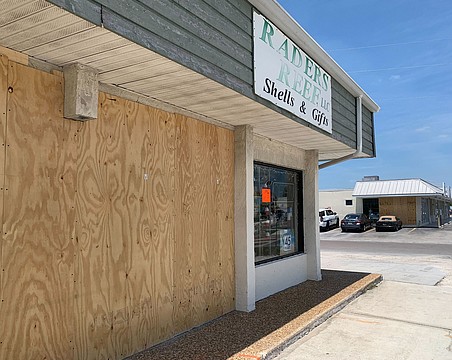The Investment Slip
entrepreneurs by Jean Gruss | Editor/Lee-Collier
The rising tide of Wall Street money is lifting Steeven Knight's business as he aims to develop a network of private yacht clubs in Florida and beyond.
Readers of the Wall Street Journal recently spotted a suggestive ad that is, well, not really the financial newspaper's typical investment offering.
It features a buxom young lady in a skimpy bikini toasting her male companion with a glass of wine while sitting on a pleasure boat at the Sanibel Harbour Yacht Club in Fort Myers. "Slip into a great investment," the ad beckons.
The message: Buying a slip for your boat will pay off in spades, financially and otherwise. These slips, it says, have appreciated an average of 35% per year for the past eight years because of surging demand and few new slips.
These eye-popping returns are a reminder of the days when condos were appreciating by double-digit percentage rates. By contrast, the Standard & Poor's 500-stock index, a basket of large-capitalization U.S. stocks, has appreciated an average of just 3.02% over that same eight-year period (not counting dividends).
"You can put your boat, which is a depreciating asset, into a slip that appreciates," says Steeven Knight, 50, the chief executive officer of Yacht Clubs of the Americas, the developer and manager of the marina. You can even buy and hold it in a tax-deferred IRA, he says.
But that's about as close to an investment pitch as you'll get from Knight. Otherwise, federal regulators might come knocking, asking why his "dockominiums" aren't registered as securities. As every investor knows, past performance is never an indication of future returns.
But the investment pitch has paid off for Knight. Borrowing more than $200 million in cheap capital from banks and Wall Street firms, Knight buys marinas struggling from rising insurance and taxes, fixes them up, adds fancy amenities such as restaurants and bars and sells slips (along with the tax and insurance burden) to individual buyers like condos. Then, he locks the slip-owner's association into a 10-year management contract with his company to operate the marina. Sales to date total $100 million.
What started as one marina near the causeway leading to Sanibel island in Fort Myers has now become a network of 11 marinas from Tampa to Naples, Key West, Stuart and New Smyrna. More are on the way up the east coast to the Carolinas, Maryland and New York as well as in places such as the Caribbean and Central America.
"We're building locations where I can take my boat," Knight says.
Parking the 50-foot Nor-Tech
Sometimes, the best business ideas arise from necessity. For Knight, it was finding a place to park his 50-foot Nor-Tech yacht.
Knight had been a successful subcontractor to the building industry in Southwest Florida, growing his company's revenues from $300,000 in 1992 to $23 million in 2004. Clients included large builders such as WCI Communities. "Al and I owned an airplane together," Knight says, referring to former WCI Chairman and current ambassador to Portugal Al Hoffman.
In 2004, he sold his company to his employees and bought the Sanibel Harbour marina for $6.25 million, property records show. With financing from Wachovia, he built a new facility to house 387 dry slips, a martini bar, a pool and a gourmet deli and coffee shop. (Dry slips are buildings on the ground that house boats in racks; wet slips are in the water.)
Knight won't say how much profit he makes on each slip, but judging by the purchase price of the marina he's doing very well. He started selling slips for $97,500 each in 2004 and has now sold 84% of them. Prices now range from $127,000 for a small boat under 30 feet in length to $240,000 for a larger boat. The average sale is $137,000 per slip.
"The exit strategy is 36 months from the sales standpoint," Knight says.
Owners have a deeded ownership to the slip and can't resell until the marina is 90% sold, keeping out speculators. "Eighty-five to 90% of my buyers are end-users," he says. In addition, the slip-owners association has to sign a contract for Knight to manage the marina for 10 years.
"I don't make money on the management business," he adds. The idea is to deliver top-notch service and supplies such as gasoline and food at cost to keep the high quality consistent among all the marinas. That means Knight doesn't outsource the restaurant or any other part of this business to outsiders. Dues average $300 a month per boat.
There's no tipping allowed either. Instead, Knight says he pays his employees above the average wage. Bartenders, for example, make $17 an hour and receive health insurance and 401(k) benefits. "In the bar business, show me a guy who gets benefits," Knight says.
A Boatload of (Wall Street) Cash
With the success of the Sanibel Harbour marina, Steeven Knight set his sights on other locations. He currently is selling and developing 11 marinas, including Tampa and Naples, and he's planning another 10 over the next five years.
So far, lenders have been eager to back his venture, Yacht Clubs of the Americas. He landed $230 million in financing from iStar Financial, a New York-based real estate investment trust to finance the expansion. Granite Partners, a real estate advisory firm in New York City, helped broker the deal.
Knight is certainly moving fast. "You outgrow the local banks," he says.
Not surprisingly, other developers are copying the idea and competition is increasing. Under pressure from rapidly increasing taxes and insurance, families who own marinas in Florida and elsewhere are eager to sell their property for top dollar.
In Florida, slip sales already have slowed because of the residential real estate downturn. Although Knight says sales are down 20% in the last seven months, he's sold $12.5 million worth of slips in the last month and a half. He says the relatively healthy stock market has helped and most of his buyers still pay cash. But demand has weakened even as competitors build new dry slips.
So Knight is looking at the Carolinas, Maryland and New York to expand his franchise in cities such as Annapolis, Yonkers and East Hampton. He's also scouting sites along the Mississippi coast.
Central America is also on the radar. Knight is eyeing a location in Cancun, Mexico, and another on the Gulf side of Costa Rica. Already, there's a Yacht Clubs of the Americas in the Bahamas.
Knight is not averse to doing joint ventures to develop new marinas. "When you learn to divide, you grow better," he says. "I'm not greedy."
Knight is also negotiating a deal with Freedom Boat Clubs, the world's largest boat-membership association with 55 locations around the country. A boat club is similar to a golf club; instead of reserving a tee time, members can take a boat out for the day. Knight declines to talk about that deal because he's still negotiating.
To redevelop a marina, Knight has developed a strategy he calls the "Good Neighbor Program." Before any plans are drafted, he visits with all the property owners surrounding the marina to ask them what they think. "What can we do to help you?"
So far, the goodwill program has worked to keep opponents from derailing a purchase. The Sanibel marina took just nine months to get approved, a record time in Florida.
REVIEW SUMMARY
Industry. Marinas
Trend. Buying slips as condos
Key. Cheap financing spurs redevelopment of marinas struggling under the weight of rising taxes and insurance.





